
WHAT IS A P2 TRUEDLY TRANSACTION ON BANK STATEMENT?
Among the various transactions, one that has puzzled many is the “P2 Truedly” transaction. This term appears to have cropped up on numerous occasions for both finance enthusiasts and frequent online shoppers. But what exactly is a P2 Truedly transaction? In this comprehensive guide, we will explore everything you need to know about P2 Truedly transactions, why they appear on your bank statement, and what you should do if you spot one.
Understanding P2 Truedly Transactions
To start, it’s important to clarify that “P2 Truedly” as a specific term doesn’t represent any known banking or financial transaction type as of this writing. It seems to be a hypothetical example, perhaps used to represent a category of transactions commonly seen in online banking today. However, we can glean insights from this example to understand similar transactions often categorized under P(2P) payments, online shopping, or digital transactions facilitated by third-party platforms.
The Rise of P2P Payments and Digital Wallets
In recent years, Peer-to-Peer (P2P) payment systems and digital wallets have revolutionized the way we transact online. Apps like Venmo, PayPal, Zelle, and numerous others allow users to send money directly to others, pay for goods and services, and even invest in cryptocurrencies and stocks. These transactions often appear on bank statements with specific codes or names that might not immediately make sense to the account holder.
Deciphering Your Bank Statement
When you see an unfamiliar transaction on your bank statement, it could be related to several activities:
- Online Purchases: Made through platforms that use generic descriptors for transactions.
- Subscription Payments: Automatic deductions that might not carry the service name.
- P2P Transfers: Names or email addresses might appear instead of traditional merchant names.
- Third-Party Payment Processors: Transactions processed by entities like PayPal may show the processor’s name instead of the actual merchant.
Investigating Unfamiliar Transactions
If you encounter a transaction you don’t recognize, such as our hypothetical “P2 Truedly,” here are steps you can take to investigate further:
- Review Your Purchase History: Check your email receipts and online shopping accounts for related transactions around the date specified.
- Check with Household Members: Sometimes, family members might make a purchase with a shared account.
- Contact Your Bank: If the transaction still doesn’t ring a bell, reaching out to your bank is a safe bet. They can provide more details and, if necessary, initiate a fraud investigation.
- Consider Fraud: Should there be no legitimate explanation, the transaction may be fraudulent, necessitating immediate action, such as blocking your card and disputing the transaction.
Protecting Yourself Against Fraud
In an era where online transactions are commonplace, protecting yourself against unauthorized or fraudulent transactions is crucial. Here are a few tips:
- Monitor Bank Statements Regularly: Checking your account activity regularly can help you catch and address any suspicious transactions swiftly.
- Use Strong, Unique Passwords: For all financial accounts and services, ensure your passwords are robust and distinct.
- Enable Alerts: Many banks offer transaction alerts via text or email. Enabling these can help you monitor account activity in real-time.
- Be Cautious With Personal Information: Be wary of phishing scams and only input personal and financial information on secure, trusted websites.
Conclusion
While “P2 Truedly” transactions may not specifically exist, the exploration into similar types of transactions prevalent in our digital-first world underscores the importance of being diligent and informed about our financial activities. By understanding the nature of P2P payments, the potential for unfamiliar transaction names on bank statements, and adopting practices to safeguard against fraud, we enhance our financial literacy and security in the evolving landscape of digital commerce.
Remember, in the complex world of online transactions, knowledge and vigilance are your best allies. Stay curious, stay informed, and never hesitate to question discrepancies in your financial statements—it’s your right and your shield against potential fraud.